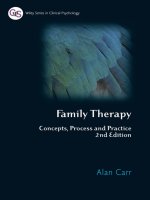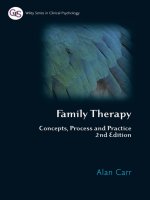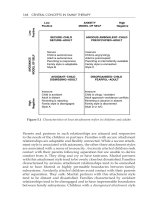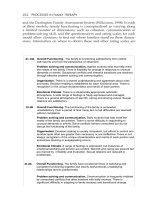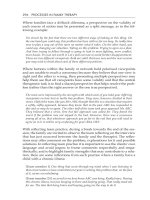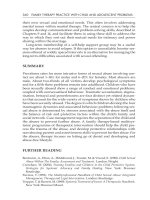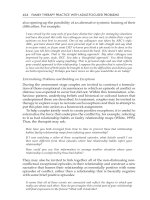Integrated process and fixture planning theory and practice
Bạn đang xem bản rút gọn của tài liệu. Xem và tải ngay bản đầy đủ của tài liệu tại đây (26.19 MB, 283 trang )
Integrated Process & Fixture
Planning
Advanced and Additive Manufacturing
Series
SERIES EDITOR
Ali K. Kamrani
University of Houston, Texas, USA
PUBLISHED
Laser-Based Additive Manufacturing of Metal Parts: Modeling,
Optimization, and Control of Mechanical Properties
Linkan Bian, Nima Shamsaei, and John M. Usher
Computer-Aided Inspection Planning: Theory and Practice
Abdulrahman Al-Ahmari, Emad Abouel Nasr, and Osama Abdulhameed
Integrated Process & Fixture Planning: Theory and Practice
Awais Ahmad Khan, Emad Abouel Nasr, Abdulrahman Al-Ahmari,
and Syed Hammad Mian
Integrated Process & Fixture
Planning
Theory and Practice
Awais Ahmad Khan
Emad Abouel Nasr
Abdulrahman Al-Ahmari
Syed Hammad Mian
A PRODUCTIVITY PRESS BOOK
Routledge
Taylor & Francis Group
711 Third Avenue, New York, NY 10017
© 2018 by Taylor & Francis Group, LLC
Productivity Press is an imprint of Taylor & Francis Group, an Informa business
No claim to original U.S. Government works
Printed on acid-free paper
International Standard Book Number-13: 978-1-4987-6373-8 (Hardback)
International Standard Book Number-13: 978-1-3151-5351-3 (eBook)
This book contains information obtained from authentic and highly regarded sources. Reasonable
efforts have been made to publish reliable data and information, but the author and publisher cannot
assume responsibility for the validity of all materials or the consequences of their use. The authors and
publishers have attempted to trace the copyright holders of all material reproduced in this publication
and apologize to copyright holders if permission to publish in this form has not been obtained. If any
copyright material has not been acknowledged please write and let us know so we may rectify in any
future reprint.
Except as permitted under U.S. Copyright Law, no part of this book may be reprinted, reproduced,
transmitted, or utilized in any form by any electronic, mechanical, or other means, now known or
hereafter invented, including photocopying, microfilming, and recording, or in any information
storage or retrieval system, without written permission from the publishers.
For permission to photocopy or use material electronically from this work, please access www.
copyright.com ( or contact the Copyright Clearance Center, Inc. (CCC),
222 Rosewood Drive, Danvers, MA 01923, 978-750-8400. CCC is a not-for-profit organization that
provides licenses and registration for a variety of users. For organizations that have been granted a
photocopy license by the CCC, a separate system of payment has been arranged.
Trademark Notice: Product or corporate names may be trademarks or registered trademarks, and are
used only for identification and explanation without intent to infringe.
Visit the Taylor & Francis Web site at
and the Productivity Press site at
Contents
Preface.................................................................................. xi
Description of Book ........................................................ xvii
Acknowledgment .............................................................. xxi
Authors .............................................................................xxiii
1 Computer-Based Design and Features .....................1
1.1 Introduction ................................................................ 1
1.2 Computer-Aided Design and Computer-Aided
Manufacturing Integration .......................................... 4
1.2.1 The Role of Computer-Aided Design/
Computer-Aided Manufacturing in
Manufacturing .................................................. 6
1.3 Feature-Based Technologies ...................................... 8
1.3.1 Types of Features ............................................10
1.4 The New Methodology Objectives ...........................13
1.5 Questions ...................................................................14
References ..........................................................................15
2 Methodologies of Feature Representations............19
2.1 Feature Definitions ....................................................19
2.2 Geometric Modeling ..................................................20
2.2.1 Wireframe Modeling .......................................21
2.2.2 Surface Modeling ............................................23
2.2.2.1 Ferguson’s Curve ................................24
v
vi
◾ Contents
2.2.2.2 Bezier Curve ................................25
2.2.2.3 B-Spline Curve .............................27
2.2.3
Solid Modeling ......................................... 28
2.2.3.1 History and Overview .................29
2.2.3.2 Types of Solid Modeling ..............30
2.3
Boundary Representation........................................31
2.3.1
Euler’s Formula .........................................32
2.4
Constructive Solid Geometry ..................................34
2.5
Advantages and Disadvantages of Constructive
Solid Geometry and Boundary Representation .....34
2.6
Feature Recognition.................................................36
2.7
Feature-Based Design .............................................37
2.8
Feature Interactions .................................................38
2.9
Computer-Aided Fixture Design .............................39
2.9.1
Feature-Based Methods ............................40
2.9.2
Knowledge-Based Engineering Method.....40
2.9.3
Case-Based Reasoning Method ................42
2.9.4
Rule-Based Method ...................................43
2.9.5
Functional and Information Models ........ 44
2.9.6
Blackboard Framework.............................45
2.9.7
Virtual Reality-Based Fixture Design ...... 46
2.9.8
Geometric and Kinetic Approaches .........47
2.9.9
Finite Element Analysis Method .............. 48
2.9.10 Genetic Algorithm Approach ....................49
2.9.11 Force Analysis Methods ............................50
2.10 Summary..................................................................51
2.11 Questions .................................................................53
References ..........................................................................54
3 Feature Extraction Techniques ..............................61
3.1
Feature Representation ............................................61
3.1.1
Feature Representation by Boundary
Representation...........................................62
3.1.2
Feature Representation by
Constructive Solid Geometry ...................65
Contents
◾
vii
3.1.3 Feature Representation by Boundary
Representation and Constructive Solid
Geometry (Hybrid Method)............................66
3.2 Feature Recognition Techniques .............................. 68
3.2.1 The Syntactic Pattern Recognition
Approach .......................................................68
3.2.2 The Logic-Based Approach ............................70
3.2.3 Graph-Based Approach ..................................72
3.2.4 Expert System Approach ................................74
3.2.4.1 Features...............................................75
3.2.5 Volume Decomposition and Composition
Approach .........................................................76
3.2.6 3D Feature Recognition from a 2D
Feature Approach .......................................... 77
3.3 Summary....................................................................78
3.4 Questions ...................................................................79
References ......................................................................... 80
4 Data Transfer in CAD/CAM Systems......................85
4.1 Need of Data Exchange ............................................85
4.1.1 Geometric Data Exchange ..............................87
4.1.2 Need of ISO 10303 Standard ..........................87
4.2 Standard for Exchange of Product Data .................. 88
4.2.1 STEP Application Protocols ........................... 90
4.2.2 STEP AP203 (Configuration Control
Design) .........................................................92
4.2.3 Description of STEP AP203 ............................93
4.3 Object-Oriented Programming .................................97
4.4 Summary................................................................... 98
4.5 Questions .................................................................. 99
References ........................................................................100
5 Automatic Feature Recognition ...........................103
5.1 Introduction .............................................................103
5.2 Feature Library ........................................................105
viii ◾
Contents
5.3 Feature Classifications .............................................106
5.4 Feature Recognition Process ...................................108
5.4.1 Feature Faces Extraction Algorithms............ 110
5.4.1.1 Case 1: Simple Features Straight
(Through and Blind) ........................ 110
5.4.2 Parallelism and Perpendicularity
Algorithms .....................................................122
5.4.3 Feature Extraction Procedure .......................123
5.4.3.1 Case 1 ...............................................123
5.4.3.2 Cases 2 and 3 ...................................124
5.4.3.3 Case 4 ...............................................125
5.4.3.4 Cases 5 and 6 ...................................127
5.4.4 Feature Recognition Rules ............................128
5.5 Summary..................................................................143
5.6 Questions ................................................................. 145
References ........................................................................146
6 Computer-Aided Process Planning ...................... 149
6.1 Introduction ............................................................. 149
6.2 Computer-Aided Process Planning ......................... 151
6.3 Approaches to Process Planning............................. 152
6.3.1 Variant Process Planning .............................. 152
6.3.2 Generative Process Planning ........................ 155
6.3.3 Hybrid Process Planning .............................. 156
6.4 Feature-Based CAPP System ................................... 157
6.4.1 Selection of Machining Operations .............. 158
6.4.2 Selection of Cutting Tool .............................. 158
6.4.3 Selection of Machine Tool ............................ 159
6.4.4 Selection of Machining Parameters ..............160
6.4.5 Setup Planning Algorithm ............................ 161
6.5 Summary..................................................................163
6.6 Questions .................................................................164
References ........................................................................165
Contents
◾
ix
7 Integration System for Fixture Layout Design .... 167
7.1 Introduction ............................................................. 167
7.2 Computer-Aided Fixture Design Module................ 173
7.3 Fixture Planning ...................................................... 174
7.3.1 Generation of Locating Scheme ................... 176
7.3.2 Determination of Locating and Clamping
Regions .......................................................... 178
7.4 Fixture Layout Design .............................................183
7.4.1 Generation of Modular Fixture Database.....184
7.4.2 Search Strategy for Fixture Modeling and
Assembly .......................................................189
7.5 Fixture Assembly .................................................... 200
7.5.1 Creation of CATVBA File..............................213
7.5.2 Generation of Automatic Fixture
Assembly......................................................214
7.6 Summary.................................................................. 219
7.7 Questions .................................................................220
References ........................................................................221
8 Application of an Integrated System for Process
and Fixture Planning ...........................................225
8.1 Introduction .............................................................225
8.2 Illustrative Example 1 ..............................................226
8.3 Illustrative Example 2 ..............................................232
8.4 Illustrative Example 3 ..............................................237
8.5 Summary..................................................................245
8.6 Questions .................................................................246
Index ..........................................................................247
Preface
Manufacturing industries have evolved as an indispensable
component of developed countries. The emergence and
advancement of computer numerical controlled machines,
robotics, cellular manufacturing, automation, and so on have
remarkably bolstered the performance of these industries in
recent times. The aspects such as superior quality, enhanced
productivity, timely delivery, justifiable cost, and so on are
critical to succeed and nurture in a customer centric market.
Therefore, the concepts, including computer-aided design
(CAD), computer-aided manufacturing (CAM), computer-aided
fixturing, computer-aided inspection, and so on, are crucial to
achieve higher customer satisfaction.
The manufacturing setups must be competent and intelligent to fabricate components or assemblies with minimal human interference. Despite extensive capital, efforts,
researches, and resources, there are still applications, which
cannot be carried out adequately in the absence of a skilled
technician, especially in the cases of small- and mediumsized productions. In these situations, where frequent design
changes occur, the fixture design process becomes a crucial
phase. It suggests that the accuracy, flexibility, and reliability
possess a substantial influence on the performance of subsequent operations in the production line. Therefore, the subject
of manufacturing fixture demands a considerable focus, thorough process and substantial effort.
xi
xii
◾ Preface
A fixture can be defined as an arrangement for locating,
holding, and supporting a workpiece in the manufacturing
operation. They are very important in manufacturing systems because they directly influence the machining quality,
productivity, and product cost. An appropriately designed
and fabricated fixture can greatly enhance the efficiency
and adaptability of the production line. Henceforth, significant effort should be directed to study, analyze, develop, and
improve the fixture design process. The likelihood of mistakes or inaccuracy is greater in the case of manual fixture
design process due to the presence of the human element.
The manual fixture design is subjective, labor intensive, time
consuming, and exhausting. Indeed, the development in
computer technology has induced the use of computer tools or
programs for fixture design. In the recent past, the evolution
of automated systems for fixture design has been a topic of
intensive research. The computerization and automation of fixture design process can be defined as computer-aided fixture
design (CAFD).
Numerous approaches have been developed for fixture
design and analysis, yet the implementation of these techniques in industries is quite challenging. It can be attributed
to the lack of practical solutions required in fixture assembly.
The lack of tools and a systematic approach to evaluate design
process has often resulted in empirical strategies.
To address these issues, there is a need to develop practical
methods in fixture assembly and to integrate different phases
of the CAFD process. The technologies and strategies for
automatic generation of an efficient fixture design process are
imperative in the advanced manufacturing systems. The significance of an integrated system is a seamless flow of information between computer-aided design (CAD), computer-aided
process planning (CAPP), and computer-aided fixture design
(CAFD) activities. The integrated model for an automated
CAFD can be very useful in bridging the gap between various
phases of the fixture design process.
Preface
◾
xiii
It allows its users to have full access from part design to
fixture synthesis. The seamless integration between different stages results in real-time response to changes in design,
setup planning, fixture design, production scheduling, and so
on. It helps to assist the design, modification, analysis, and
manufacture of parts automatically and efficiently within the
specified time.
The motivation behind this book is the demand of rapid
generation of conceptual and detailed fixture designs in product and production design stages as well as providing tools
for fixture design. Most books developed so far in the fixture
design areas have not discussed methodologies in detail, which
generate a link between process planning and fixture layout
design/assembly under an integrated platform. This book introduces and implements a new methodology for the generation of
the automated process plan and fixture design using the objectoriented platform. It provides an integrated solution with a CAD
application such as CATIA V5 for final fixture layout design.
It offers an insight into the methods and techniques that can be
used in fixture layout planning in an integrated fashion. The
following procedure can be adopted to develop an integrated
model for an automatic CAFD: generation of a 3D solid model,
part geometric data extraction, feature recognition, development
of the computer-aided process plan, generation of the setup
plan, determination of the feasible locating scheme and suitable
locating/clamping regions, respectively, establishment of the
most appropriate locating and clamping points, and finally the
generation of the final fixture assembly in CAD software such
as CATIA V5 using CATVBA Editor. The developed integrated
system exhibits numerous characteristics such as application of
artificial intelligence technique in fixture planning phase, fixture
design solution for multiple setups, fixture layout design using
standard modular fixture elements, and so on.
CAFD is a complicated task, which requires a detailed
understanding of the fixture design process. To better understand this concept, a comprehensive study of fixture design
xiv ◾ Preface
textbooks and different CAFD systems should be done.
Therefore, this book has been structured in such a way that it
will be suitable for a variety of courses in design and manufacturing. It is the result of an extensive research and development in this area. The proposed methodology has been
implemented, tested, and validated. The book comprises of
advanced topics such as automatic process planning and fixture layout design. This book can broadly be classified into
three sections—(1) CAD/CAM and feature representation,
(2) feature extraction and recognition, and (3) fixture design
process. The brief overview of different chapters is as follows.
Chapter 1: Computer-Based Design and Features. This chapter
gives an overview of computer-aided design and manufacturing
(CAD/CAM), the importance of CAD/CAM integration in manufacturing, the role of CAD/CAM in manufacturing, and so on.
Chapter 2: Methodologies of Feature Representations. This
chapter defines feature and provides different modeling techniques, including wire-frame modeling, surface modeling, and
solid modeling. It discusses Ferguson’s curve, Bezier’s curve,
B-spline curve in addition to boundary representation (B-rep),
and constructive solid geometry (CSG).
These techniques are used to facilitate feature recognition process. The CAFD methods including the feature-based
method, knowledge-based engineering method, case-based
reasoning method, rule-based method, functional and information models, blackboard framework, virtual reality-based
fixture design, geometric and kinetic approaches, finite element analysis method, genetic algorithm approach, and force
analysis methods have also been described.
Chapter 3: Feature Extraction Techniques. This chapter outlines feature representation and recognition techniques. The
feature recognition techniques including the syntactic pattern
recognition approach, the logic-based approach, graph-based
approach, expert system approach, volume decomposition and
composition approach, and 3D feature recognition from a 2D
feature approach have been reported in this chapter.
Preface
◾
xv
Chapter 4: Data Transfer in CAD/CAM Systems. This chapter
presents the need of data exchange and ISO-10303 standard
toward the standardization of product data and compatible
exchange of information among various CAD and CAM systems. The STEP format is discussed elaborately as one of the
popular standard formats. The object-oriented programming
concept has also been presented in this chapter.
Chapter 5: Automatic Feature Recognition. This chapter briefs
about different types of features such as single, compound,
and intersecting features. It also provides rules for feature
recognition process, feature extraction procedure and algorithms,
and so on.
Chapter 6: Computer-Aided Process Planning. This chapter
presents the concept of CAPP and approaches of process
planning, that is, variant process planning, generative process
planning, and hybrid process planning. The feature-based
CAPP system has also been illustrated.
Chapter 7: Integration System for Fixture Layout Design.
It outlines the CAFD module. This chapter also provides a
methodology for setup planning in the fixture design process.
It discusses algorithms for the generation of locating scheme
and the determination of locating and clamping regions.
Moreover, it represents the generation of modular fixture
database and the search strategy for fixture modeling and
assembly. The creation of CATVBA file and the generation of
automatic fixture assembly have also been described.
Chapter 8: Application of an Integrated System for Process
and Fixture Planning. This chapter implements and validates
the proposed methodology of the integrated system for system
through various case studies.
Awais Ahmad Khan
Emad Abouel Nasr
Abdulrahman Al-Ahmari
Syed Hammad Mian
Description of Book
Fixtures are essential elements of production processes as
they are required in most of the automated manufacturing,
inspection, and assembly operations. Although fixtures can
be designed using CAD functions, lack of tools and a systematic approach to the evaluation of design performance
leads to trial-and-error strategies. The manual fixture design
requires the consideration of a number of factors like primary
requirements of the design, demand to be met, use of automated and semi-automated clamping devices, safe operation,
and so on. The application of these fundamental principles
to an individual fixture design depends primarily on the
designer’s experience. Such issues create limitations in the
advancement manufacturing industry. Trends in manufacturing
industry toward the flexible manufacturing systems demand
the development of technology and strategies for automatic
generation of an efficient fixture design process. Motivation
of computer-aided fixture design (CAFD) has been derived
from the demand of rapid generation of conceptual and detail
fixture designs even in product and production design stages,
providing tools for fixture design. This book introduces and
implements a new methodology and develops the supporting
technologies for automated process and fixture planning using
an object-oriented platform. It also provides an integrated
solution with a computer aided design (CAD) application like
CATIA V5 for final fixture layout design.
xvii
xviii ◾
Description of Book
Approach
This book offers insights into the methods and techniques that
enable implementing fixture layout planning by incorporating advanced methodologies and technologies in an integrated
approach. It is the need of time to device the systematic methodologies that integrate design within an automated environment
rather than designing the actual fixture itself. The book includes
advanced topics such as automatic process planning and fixture
layout design. It will be structured in such a way that it will be
suitable for a variety of courses in design and manufacturing.
Most books developed in the fixture design areas (Nee et al.,
etc.) are not able to provide a link between process planning
and fixture layout design/assembly under an integrated platform.
This book provides an efficient link between process planning
and fixture layout design, and it uses practical approaches in
fixture assembly using standard available fixture accessories.
The book is the result of extensive research and development in this area. The proposed methodology has been implemented, tested, and validated.
Target Readership
Institute of Industrial Engineers (IIE)
Society of Manufacturing Engineering (SME)
The Institute for Operations Research and the Management
Sciences (INFORMS)
Engineering Management Society
American Society of Mechanical Engineers (ASME)
Most books developed in the inspection area are very theoretical, although this book is designed in such a way to address
more practical issues related to design and inspection. This
will introduce and discuss theoretical topics, but mainly in
applications and implementations contexts.
Description of Book ◾
Marketing Information
Institute of Industrial Engineers (IIE)
Society of Manufacturing Engineering (SME)
Engineering Management Society
American Society of Mechanical Engineers (ASME)
xix
Acknowledgment
The authors are grateful to the Raytheon Chair for Systems
Engineering for funding.
xxi
Authors
Awais Ahmad Khan is a researcher at the Advance
Manufacturing Institute, College of Engineering, King
Saud University, Saudi Arabia, and assistant professor in
the Mechanical Engineering Department, University of
Engineering & Technology, Lahore, Pakistan. He received his
PhD in industrial engineering from King Saud University in
February 2015. His current research focuses on feature recognition, process planning, fixture design and analysis, die
design, and flexible manufacturing systems.
Emad Abouel Nasr is a professor in the Industrial
Engineering Department, College of Engineering, King Saud
University, Saudi Arabia, and the Mechanical Engineering
Department, Faculty of Engineering, Helwan University,
Egypt. He received his PhD in Industrial Engineering from the
University of Houston, Texas, in 2005. His current research
focuses on CAD, CAM, rapid prototyping, advanced manufacturing systems, supply chain management, and collaborative
engineering.
Abdulrahman Al-Ahmari is the dean of the Advanced
Manufacturing Institute, executive director of CEREM (Center
of Excellence for Research in Engineering Materials), supervisor of Princess Fatimah Alnijris’s Research Chair for Advanced
xxiii
xxiv ◾
Authors
Manufacturing Technology, and supervisor of CMTT (Center
of Manufacturing Technology Transfer). He received his
PhD (manufacturing systems engineering) in 1998 from the
University of Sheffield, United Kingdom. His research interests are in analysis and design of manufacturing systems,
Computer Integrated Manufacturing (CIM), optimization of
manufacturing operations, applications of simulation optimization, FMS, and cellular manufacturing systems.
Syed Hammad Mian is working as a researcher at the
Advanced Manufacturing Institute, College of Engineering,
King Saud University, Saudi Arabia. He has completed his
master’s degree in industrial engineering and bachelor’s degree
in mechanical engineering. His current research focuses on
computer-aided inspection, CAD/CAM, metrology, reverse
engineering, and additive manufacturing.
